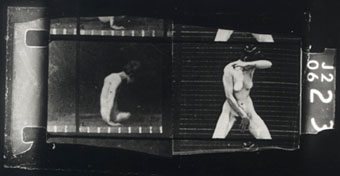"L'assassino nudo" 1984
Film 16 mm bianco e nero, muto, 18 ftg/s, 43'
(dedicato a E.Muybridge)
L’assassino nudo. Si sa che Muybridge è stato nel contempo un grande fotografo e un assassino, giustiziere dell’amante della moglie e nella sua station physiologique (come l’aveva definita per sé, Marey) pare non sia entrato un solo negro. Spogliava però donne di servizio, disoccupati, modelle di Stato, forzuti, malati e prostitute. Tutti dovevano correre, correre assieme alle bestie sotto il sole di Palo Alto. In questo Barnum-ambiente, malinconica Arca di Noè, appariva lui, Muybridge, come lavoratore nudo. Nel film non mi sono tanto preoccupato dello studio del movimento (mi pareva scontato) ma di una mia curiosità cinetico-esistenziale che quel luogo poteva essere stato; il tutto, ripreso dall’inchiostro di tre libri. Ho appunto tentato di animare l’inchiostro di immagini in movimento… ma fisse. Dunque un film desunto dall’inchiostro di stampa. Incredibile, quanto Nièpce avesse ragione. Nel montare il film ho scoperto quello che non avrei mai potuto scoprire sfogliando i tre libri cioè, una involontaria anticipazione del montaggio filmico da parte di Muybridge. Addirittura, le sue angolazioni di ripresa ci risultano come perfetti stacchi televisivi di eccezionale attualità: montaggi diretti prima che fosse cinema. Molti studiosi ora avranno già chiarito tutto questo, ma a me è parso magico lo stesso vedere (con molta fatica) sommarsi tutte le fotocamere di Muybridge in una cinecamera, la mia. Questo è un film-libro dunque, da sfogliare.
L’assassino nudo [The Naked Killer]. It is known that Muybridge was at the same time a great photographer and a killer, executioner of his wife’s lover and that into his own station physiologique (to use Marey’s term for his own working laboratory), it seems, not a single black man ever entered. Female servants, the unemployed, artists’ models supplied by the State, musclemen, the infirm and prostitutes were all undressed there. They all ran, people as well as animals under the sun of Palo Alto. In this P. T. Barnum style atmosphere, a melancholy Noah’s Ark, Muybridge himself would appear as a laborer nude. In the film, I was not so much concerned with the study of movement (it seemed a bit predictable) but with an aspect of my own cinematic-existential curiosity: that such a place could have existed; the entirety of it, I rephotographed from the typographic ink of three books. I tried precisely to reanimate the typographic ink of images in motion… but instead I fixed them. So, it’s a film derived from typographic ink. Incredible, Nièpce was so right. While editing the film, I discovered something I could never have noticed while leafing through the pages of the three books, that is, a unintentional anticipation of film editing by Muybridge. Actually, his camera angles resemble for us perfect extracts from strikingly contemporary television newscasts: live editing before cinema even existed. Many scholars have no doubt gone into all of this, but to me it seemed magical to see the same thing (with a great deal of effort), which had been compiled by all of Muybridge’s photographic cameras, appear in a single movie camera, my own. This is, then, a book film, to be leafed through.
